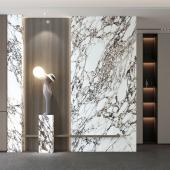Emotional colour combinations for interiors
Azzurra Bimbi - Esmalglass-Itaca Group
Colour is the subject of ongoing scientific and artistic studies, but when we think of the spaces we live in we often fail to consider that here too colour is a conscious decision rather than a random choice or purely a question of taste. We continuously find ourselves in interiors where colour combinations create different spatial perceptions. Some provide guidance on how we should move around and orient ourselves inside spaces while others aim to convey sensations, but in all cases colour – or rather the combination of colours – always conveys a message.
In interiors we can identify some main types of space defined by the different colour combinations.
These include the environments defined by the so-called “harmonic colour combinations”. They are formed from complementary colours such as primary yellow, red and blue. They are the highest expression of colour contrast and generate a vibrant but controlled energy.
In the 1920s, Johannes Itten taught his students at the Bauhaus that this condition was conducive to conveying balance and was perceived with a sense of gratification on the part of the observer. Precisely because they are “opposites” in the mechanism of visual perception, these colours reference each other without ever merging, resulting in a vibrant luminosity that is simple, almost primordial, but at the same time extremely powerful. Different shades of red, blue and yellow are applied indiscriminately to rigid and soft materials to create universal spaces filled with energy. Space is perceived clearly as it consists of distinct, separate zones that are easy to identify, comfortable and open, and so striking as to be difficult to ignore.
Combinations of clearly distinct colours, even those that are not so far apart on the colour scale, can convey a sense of order and balance. One example is the palette of colours chosen in 2006 by the practice Périphériques Architects for the expansion of the Jussieu Campus in Paris, which displays a well-balanced use of colours with equal levels of luminosity despite being clearly distinct in terms of shade. Vitamin colours serve to convey a delicate and fresh chromatic energy and guide university students through an extremely intricate building complex. The rigour of this architectural structure coexists with the fresh, natural colours that traverse the large volume and guide users like Ariadne’s threads.
A growing trend in the opposite direction involves creating spaces in which colours are combined according to a novel tonal proximity, such as blue with blue-green or orange with red and pink. Known as “analogous colours”, they share a common base colour and when juxtaposed create compositions that are light and ephemeral, serene and delicate, dynamic but not overly energetic, and always comforting. Guided by this shared colour, our gaze runs through the scene along a directional path with a beginning and an end. The result is a highly expressive and creative space imbued with rare elegance.
A third proposal concerns monochromatic spaces based on ton sur ton colour schemes. These create a sense of being immersed in an almost unreal scene where everything is carefully calibrated. The dominant colour, expressed in a variety of shades, becomes the common thread that allows for the juxtaposition of different materials while maintaining a sense of order. We sometimes observe a predominance of pale, warm and bright tones that create spaces whose simplicity evokes a sense of calm and rest, almost silent sanctuaries that counterbalance our constantly hyperconnected world, the noise and frenetic pace of urban living. These are sparsely decorated spaces where materials, details, patterns and finishes easily stand out.
Standing as the exact opposite of monochromatism but still offering an escape from the frenetic pace of urban life and the present is the pastiche space, where it is impossible to discern a code, a key to understanding the meaning and sense of balance. Nonetheless it expresses a sense of exclusivity: we perceive it as a whole and are inevitably attracted to it. The absence of a clearly visible code in fact gives rise to a new form of equilibrium. In this case we experience a sense of gratification based on the enjoyment of a spontaneous and uncensored beauty which blends the present with the past, reality with dreams, desire and passion with rationality.
Read the complete article published on Ceramic World Review 125/2018
Did you find this article useful?
Join the CWW community to receive the most important news from the global ceramic industry every two weeks





















